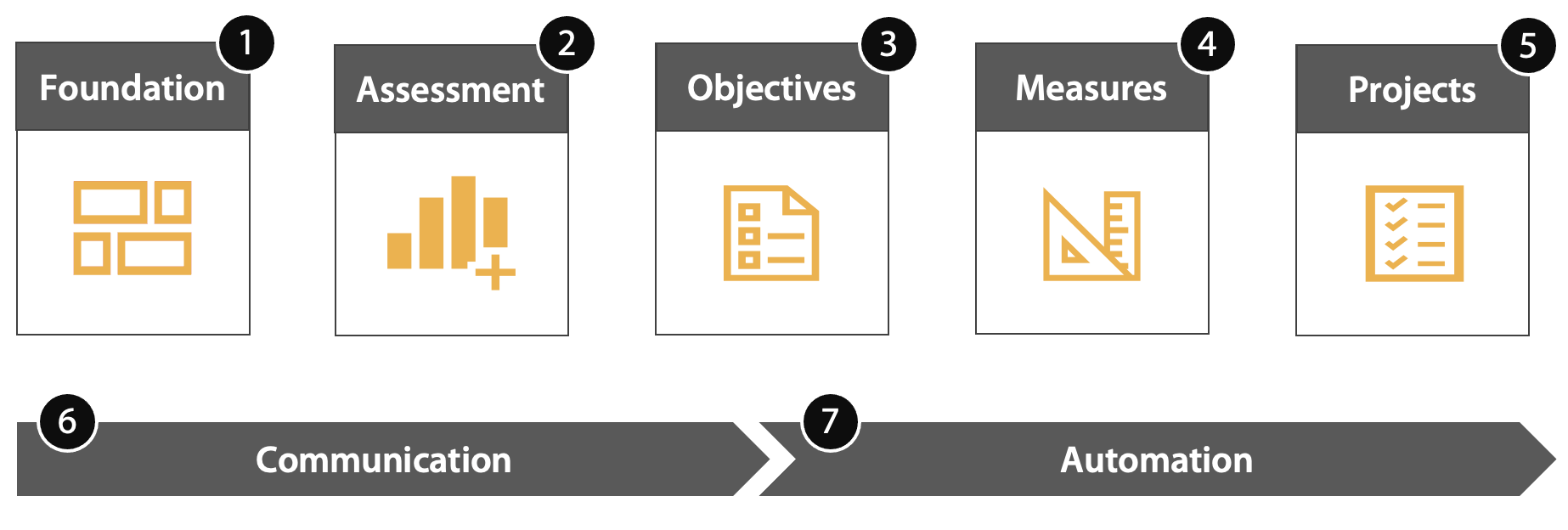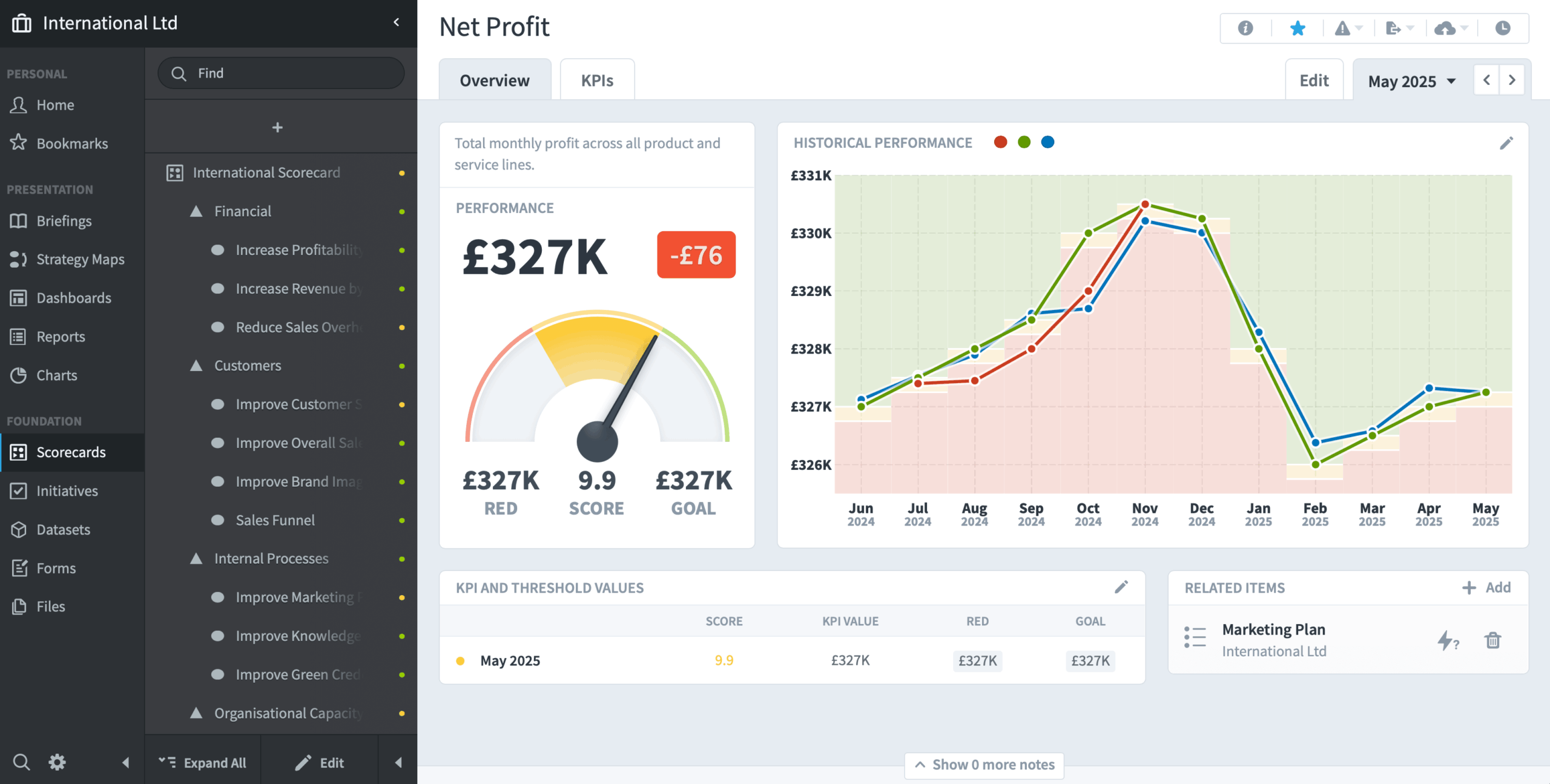Strategic Planning
Align goals. Focus teams. Achieve more.
Strategic planning turns long-term vision into focused action — when it’s done right. Start with a clear process and the right tools.
What is Strategic Planning?
Strategic planning helps organisations align long-term goals with real-world actions. With a clear 7-step process, the Balanced Scorecard, and the right software tools, you can build a strategy that delivers measurable results, not just a set of PowerPoint slides or a document that gathers dust on a shelf.
At Intrafocus, we’ve helped hundreds of organisations transform ambitious goals into measurable outcomes using a proven approach that combines clarity, flexibility, and the power of automation.
Explore how strategic planning works, why it matters, and how to make it truly actionable — with a 7-step framework, the Balanced Scorecard, and the tools to put your plan into practice.
The seven-step strategic process is based on the principles of the balanced scorecard
Why Strategic Planning Matters
Most organisations have goals. Far fewer have a plan to achieve them.
Strategic planning gives your organisation a structured way to turn ambition into action. It ensures that your teams aren’t just busy — they’re busy doing the right things. Without a clear plan, it’s all too easy to chase short-term wins, duplicate efforts, or lose sight of what really matters.
A good strategic plan answers three critical questions:
- Where are we now?
- Where do we want to go?
- How will we get there?
This isn’t about writing a glossy document that sits on a shelf. It’s about making real choices. Deciding what to prioritise. Defining measurable outcomes. And giving everyone in the organisation a shared direction.
When planning is done well, it creates focus, improves communication, and strengthens accountability. It aligns departments, projects, and KPIs to a common purpose — helping everyone pull in the same direction. Most importantly, it helps leaders make better decisions in a fast-moving world.
In recent years, the pace of change has only accelerated. AI, automation, and global market shifts have raised the stakes. The organisations that succeed are the ones that plan proactively, adapt quickly, and measure what matters.
Whether running a global division or a growing team, strategic planning gives you the edge. It’s not a luxury — it’s a leadership essential.
The Value of a Proven Process
Every successful strategy starts with a sound process. Without one, even the best ideas fall apart.
That’s why we developed the Seven-Step Strategic Planning Process (SPP), a practical, flexible framework that turns strategic planning from a one-off event into a repeatable cycle of improvement. It’s designed to help organisations at any stage of maturity align their efforts, measure what matters, and execute with confidence.
The problem with many strategic plans is that they are built in isolation. A few senior leaders gather off-site, brainstorm bold ideas, then return to business as usual. The result? No shared understanding. No ownership. No traction.
Strategy Workshop
A hands-on, facilitator-led strategy workshop built on the Balanced Scorecard methodology.
- Type: Workshop, teaching, and guided strategic planning exercises
- Location: On-site (your location)
- Participants: 6-24 people
- Duration: Three consecutive mornings
- Price: Per delegate (please enquire)
The workshop is priced per delegate. Please contact us today to receive a quote.
Strategic Planning Professional
By completing this workshop, you’ll earn certification in the Strategic Planning Process (SPP) — a proven seven-step methodology used by successful organisations worldwide.
Continuing Personal Development (CPD)
The three-day course provides a minimum of 18 hours of CPD accreditation. This number can be increased if supplementary exercises are required.
Strategy Document
Our workshop output is fully documented in a structured Strategy Document:
-
Your Integrated Strategy Map
-
Objectives, KPIs, and initiatives
-
Photos of the whiteboard and workshop outputs
View Sample Strategy Document below:
The SPP fixes that by taking a structured, inclusive approach that connects leadership vision to frontline execution. It walks you through seven clear steps:
- Foundation – Define your core purpose, vision, and values
- Assessment – Analyse your current state with tools like SWOT, gap analysis, and benchmarking
- Strategic Objectives – Translate priorities into tangible goals across four performance areas
- Measures – Identify KPIs to track your progress
- Projects – Define the work that will drive change
- Communication – Ensure everyone understands and supports the plan
- Automation – Use the right tools to monitor and adapt in real-time
The real strength of the process is its adaptability. You don’t need to follow every step rigidly. Instead, you apply what’s relevant to your organisation’s needs, timeline, and culture. Companies of all sizes have successfully adopted the SPP, from agile leadership teams to large enterprise units looking for better focus and alignment.
Why the Balanced Scorecard?
A great plan needs more than just a to-do list. It needs a way to measure progress across the whole organisation, not just financially, but strategically. That’s where the Balanced Scorecard comes in.
Developed in the 1990s by Robert Kaplan and David Norton, the Balanced Scorecard is one of the world’s most widely used strategic management frameworks. It helps organisations translate strategy into action by tracking performance across four key perspectives:
-
Financial – Are we delivering value to our stakeholders?
-
Customer – Are we meeting customer needs and expectations?
-
Internal Processes – Are our operations effective and efficient?
-
Organisational Capacity – Do we have the skills, systems, and culture to grow?
By using these perspectives, leaders can avoid focusing only on short-term financials. Instead, they can take a more holistic view of what drives success today and tomorrow. The Balanced Scorecard fits naturally within the SPP framework. In Step 3 (Strategic Objectives), these four perspectives help ensure that goals are balanced and aligned. In Step 4 (Measures), they guide the development of meaningful KPIs that tell the full performance story.
It also improves communication. When everyone understands how their work contributes to the bigger picture, not just profit margins but also customer satisfaction, innovation, and team development, they’re more engaged and accountable. Whether you’re a strategy director, a team leader, or a member of the executive board, the Balanced Scorecard gives you a clear line of sight between vision and results.
Bringing It All Together with Spider Impact
Strategic planning works best when it’s visible, trackable, and easy to manage. That’s where Spider Impact comes in. Spider Impact is a strategy management platform built specifically for frameworks like the Balanced Scorecard. It brings your entire strategic plan to life — in one place, in real time. Instead of juggling spreadsheets, PowerPoint decks, and disconnected reports, Spider Impact gives you:
-
Live dashboards to track your KPIs
-
Interactive strategy maps to visualise goals and dependencies
-
Automated reporting that keeps everyone aligned and informed
-
Project tracking so you can see what’s driving results
It integrates seamlessly with your data sources, making monitoring progress, adjusting priorities, and keeping your strategy front and centre easier. For organisations following the Seven-Step Strategic Planning Process, Spider Impact is a natural fit. It supports every stage — from defining objectives and KPIs to automating reporting and sharing progress across the business. It turns strategic planning from a static document into a living, breathing system.
Spider Impact is used by businesses, governments, and non-profits worldwide to improve focus, accountability, and performance. Whether you’re managing a small team or a large division, it helps you stay on course and prove the impact of your strategy.
Download the Strategic Planning Workbook
Ready to put structure behind your strategy? Our free Strategic Planning Workbook gives you everything you need to get started, whether you’re building your first plan or refining an existing one.
Inside, you’ll find:
-
A breakdown of the Seven-Step Strategic Planning Process
-
Guidance on using the Balanced Scorecard effectively
-
Real-world examples and practical templates
-
Tips on choosing the right KPIs and tools
This guide has been downloaded by hundreds of teams looking to improve alignment, accountability, and results. It’s designed to be clear, concise, and immediately useful — no jargon, no fluff.
👉 Download a copy of the Strategic Planning Workbook
Frequently Asked Questions
What is strategic planning?
Strategic planning is defining an organisation’s direction and deciding to allocate resources to pursue that direction. It involves setting long-term goals, understanding internal and external environments, and creating a roadmap to achieve measurable outcomes. A good plan connects vision to action and ensures that every department and team understands their role in delivering success.
How is strategic planning different from business planning?
Strategic planning is about setting long-term direction and aligning the organisation around key priorities. Business planning tends to focus on short-term operational and financial plans, often for budgeting or forecasting. Strategic planning looks at the “why” and “where we’re going,” while business planning focuses more on the “how” and “what we’ll do this year.” Both are important, but strategy always comes first.
Who should be involved in strategic planning?
Strategic planning should involve leaders from across the organisation, not just senior executives. Involving department heads, team leads, and key frontline staff helps ensure the plan reflects reality and builds ownership. The more inclusive the process, the more effective the execution. It’s not a one-person job; it’s a collaborative effort that benefits from diverse input.
What are the benefits of using a strategic planning process?
A defined process brings structure, clarity, and repeatability. It helps you make better decisions, allocate resources effectively, and align your people around a shared vision. It also makes progress easier to measure and adapt to. Without a process, planning often becomes inconsistent and ineffective, producing documents that look good but don’t deliver results.
Why use the Balanced Scorecard in strategic planning?
The Balanced Scorecard ensures your plan covers all critical areas, not just financial performance. It balances short-term and long-term priorities across finance, customers, internal operations, and organisational capacity. This holistic view improves alignment, helps you define meaningful KPIs, and creates stronger connections between strategy and day-to-day activity. It’s a powerful tool for turning strategy into action.
How can software help with strategic planning?
Strategic planning software like Spider Impact centralises your plan, KPIs, and reporting. It reduces reliance on spreadsheets and manual updates, enabling live dashboards, visual strategy maps, and automated reporting. This saves time and improves visibility, accountability, and responsiveness. It turns your strategy into a dynamic system that guides real-time decisions.
Is this approach suitable for large organisations or just smaller teams?
This approach is scalable. We’ve worked with small teams, large departments, and entire business units within global corporations. Whether you’re leading a division in a multinational company or managing a standalone organisation, a structured planning process, Balanced Scorecard framework, and strategy software can all be tailored to your size and complexity.
Start Planning with Confidence
Strategic planning doesn’t need to be complicated, but it does need to be intentional. With the proper framework and tools, you can align your organisation, focus your resources, and deliver results that matter. Whether you’re revisiting your strategy or starting fresh, we’re here to help.
👉 Download the Strategic Planning Workbook
👉 Explore the Seven-Step Strategic Process
👉 See Spider Impact in action [ask for a demonstration]
Bookmark this page — your strategy deserves more than guesswork.



